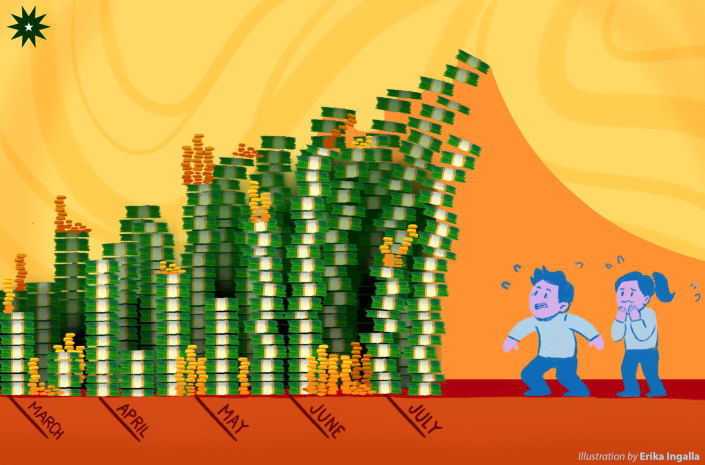Shuttered storefronts, vacant schools, empty airways—these are only some of the sights that typify what the International Monetary Fund dubs as the “Great Lockdown”. In a massive disruption of economic activity, the COVID-19 pandemic that already pushed many businesses into bankruptcy has also left five million Filipinos out of work, now dependent on government assistance and aid from the private sector.
The staggering financial burden of providing relief to ordinary citizens and sustaining response efforts has driven the nation’s economic managers to consider a less desirable source of funding: debt.
Already, the steep rise in government borrowing has generated a new wave of anxiety as debt levels reached a record-high P9.05-trillion last June. Divided by the entire population of the Philippines, every Filipino’s share of the national debt stands at P83,239.
But the Department of Finance (DOF) dismisses the simplistic computation. As Finance Assistant Secretary Tony Lambino explained, “The perspective that really matters is how much do we owe versus the size of our economy.” DOF Secretary Carlos Dominguez III himself tried to dissuade public fears, asserting in a forum last July, “We are borrowing at very low rates, and we have the capacity to pay this loan in the future.”
Not everyday debt
For ordinary Filipinos, the word “debt” may trigger unpleasant memories, bringing back difficult experiences with paying off credit card bills or loan sharks. The Philippines itself suffered from the blowback of a debt crisis under the presidency of Ferdinand Marcos, who embarked on a borrowing spree to finance white elephant projects—investments with little to no economic return.
As School of Economics Associate Dean Dr. Mitzie Conchada explains, government debt bears some similarities with household debt. “When we borrow from international institutions or even [from the] domestic [market], we pay a certain amount of interest rate,” she says. “The difference is how we use the money: for household, it’s for personal use; but for the government, it’s for social services and activities.” Conchada cites investment in education and infrastructure, which churn out long-term benefits, as a good use for debt.
In essence, government debt is primarily used to fuel growth in the economy, represented by the Gross Domestic Product (GDP), the total value of all goods and services produced within the country.
According to data from the Bureau of the Treasury, the country’s debt surged from P3.81-trillion in 2004 to P7.73-trillion by the end of 2019. But at the same time, government borrowings helped the pre-COVID-19 economy to expand.
The current size of debt against the GDP, also known as the debt-to-GDP ratio, has, in fact, been steadily decreasing. From a high of 74.4 percent in 2004, the debt-to-GDP ratio fell to about 45.1 percent at the end of 2019, meaning the economy grew much faster than debt accumulated.
Alfonso Sevidal, a Finance and Accounting Department instructor at Ateneo de Manila University, believes that the Marcos regime’s debt crisis is to blame for Filipinos’ excessive fear of debt today. The country’s current debt profile is “much healthier”, he assures, as the share of government revenue used to pay off debts has gone down.
Data from the DOF show that interest payments as a percentage of government revenue have also dropped. From 37.1 percent in 2006, interest payments now only equal 12.3 percent of government revenues.
Sevidal adds that international credit rating agencies have also shown their trust in the Philippines’ capability of paying off its debts, with Moody’s, Standard & Poor’s, and Fitch Ratings assigning the country a rating of Baa2, BBB+, and BBB, respectively—which, although average marks, indicate a stable outlook for the country.
“I would be more worried, if the government could not [borrow] anymore,” Sevidal expresses. “If the bank cuts your line, then you know there’s a problem.”

Warranted anxieties
For Conchada, the fears over debt still remain valid, especially since spending borrowed money on social amelioration and pandemic response programs—which, based on DOF’s latest data, has ballooned to P372-billion in the past few months—is complicated. “These don’t generate much investments in the long run,” she elaborates, “and that’s one area [where] people are concerned. Economists and people in the academe worry how the government is spending [the money].”
The country’s debt-to-GDP ratio is expected to make a steep climb again, although finance officials promised to keep the figure to within 50 percent. Conchada expresses confidence that policies set by the Bangko Sentral ng Pilipinas and the DOF provide a buffer from the negative effects of borrowing or a possible debt crisis.
Indeed, Fitch Ratings already issued a warning last August 10 that new lockdowns might decay the country’s credit rating, highlighting the government’s precarious situation. “Curtailing pandemic-related spending may be difficult if the economy continues to contract and fails to recover as fast as the authorities expect,” the statement read.
Other options to pump funds into the government’s COVID-19 response are also limited. Last June, the Bureau of Internal Revenue and the Bureau of Customs reported a steep 24.8 percent drop in tax collections compared to the previous year. Plans to impose new taxes on online sellers and online transactions received heavy flak from ordinary citizens already struggling amid the economic recession. With limited choices for raising funds, Conchada describes borrowing as one the “easiest ways” to approach the problem. “It’s like we are choosing from lesser evils,” she remarks.
Should debt be feared? Sevidal believes that “the fear should always be there”. “But I think the greater fear is if we cannot borrow any more to fund our relief and rehabilitation,” he maintains. “I think that’s the greatest fear [that] deserves attention.”
